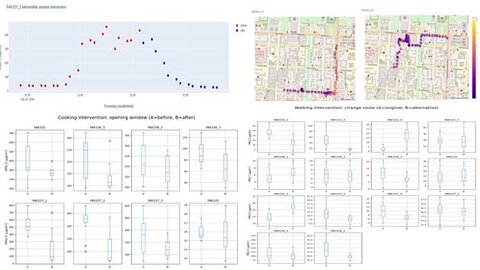FRESHAIR4Life: The efficacy of interventions to reduce personal exposure to indoor and outdoor airborne particulates in Bishkek, Kyrgyzstan
27 Mar 2025
Introduction: Personal exposure to airborne particulates and its health effects is a worldwide concern. This research evaluates the efficacy of simple interventions for reducing personal particulate exposure of sizes less than 2.5μm (PM2.5): opening windows whilst cooking indoors; and, choosing alternative walking routes that avoid vehicle-busy streets. PM2.5 concentration (μg/m^3) was measured at 30s intervals using the wearable Airspeck-P monitor, and communicated wirelessly to an Android app for onward transmission (with time- and GPS-stamps) to the GoogleCloud for storage.
Methodology: Cooking Indoors - The protocol for cooking was standardised to toasting a single slice of white bread in a pan in a closed kitchen. The kitchen window was opened once the toast was overdone and started smoking. The scatterplot (Fig1-top-left) illustrates the rise and fall of PM2.5 values pre- and post-intervention (in red and blue colours).
Walking Outdoors - Subjects wearing the Airspeck-P monitor were invited to walk along main roads during the forward journey, and reversed back to the starting-point using side streets during the return journey. The two maps (Fig1-top-right) illustrate the personal PM2.5 concentrations during the walking journeys.
Results: The two box-plots (Fig1-bottom) capture succinctly the PM2.5 concentrations pre- and post-intervention during cooking (left) and walking (right) activities. The average PM2.5 levels before and after opening the window during cooking were 257.9μg/m^3 (SD-99.5μg/m^3) and 144.2μg/m^3(SD-85.8μg/m^3), respectively, resulting in a reduction of 44.1%.
The average reduction in PM2.5 exposure using alternative routes was 17.4%, with average PM2.5 concentrations of 28.7μg/m^3 (SD-12.9μg/m^3) along busy roads, and reducing to 23.7 (SD-6.4μg/m^3) along side-streets.
Discussion: The cooking intervention is easy to understand and simple to implement with uniform improvements in PM2.5 levels. In contrast, 'walking' interventions gain when traffic is the dominant source, but less so in outlying areas of Bishkek where solid-fuel emissions for domestic heating was dominant (FAK102_4/108_1/107_2).

Resource information
Respiratory topics
- Risk factor: indoor air pollution
- Risk factor: outdoor air pollution
Type of resource
Abstract Project(s)
- FRESHAIR4Life
Conference
Brasov 2025